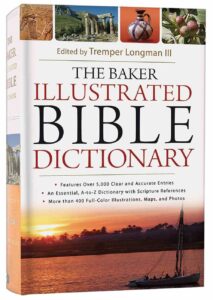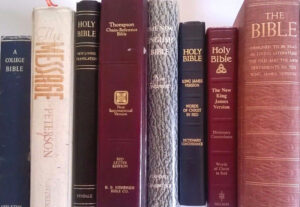Nov
10
A Blueprint for Getting More from Your Bible Reading
“Visit many good books, but live in the Bible.” — Charles H. Spurgeon, Christian theologian known as the ‘Prince of Preachers’
Regular reading in God’s Word is an important part of Christian life and practice (Psalm 119; John 8:31-32; 2 Tim. 3:16-17). But, to be honest, it isn’t always easy. Sometimes it’s the particular book or passage(s) in question that are difficult to get through (e.g., Leviticus), while other times it may be just sticking to a regular schedule that’s hard. I get it, believe me. I didn’t read the Bible on a regular basis for many, many years, and it was just a few years ago that I finally determined to develop the habit.
Now, I’m not a Bible teacher or elder, but I think I have a few valuable suggestions based on my own experience, as well as gleaned from those more biblically-informed than I am. To clarify a bit more, while some of these suggestions would be equally appropriate for in-depth Bible study (either exegetical or topical), my comments are only regarding time spent during a regular read-through of the Bible. This is why I’m not recommending commentaries, because those would be used in deeper study. (Having said that, a shorter, one-volume commentary on the Bible would be good to have nearby for quick reference, as it might help with #s 4 & 5 below.)
Clear? Alright, here is my 9-point blueprint for getting more from your Bible reading:

1) Schedule regular time.
Block out a time (or two) in your daily schedule that is dedicated to your reading — e.g., morning before or during breakfast, during commute (assuming it’s a longish commute and you aren’t reading while driving), lunch hour, evening (e.g., after kids are in bed), etc. Maybe read aloud with another person (e.g., spouse, roommate). If necessary, tell another believer or two about your “reading project” to hold you accountable.
People read at different speeds, and speed affects reading comprehension. So allow for sufficient time to get through however many pages your schedule requires for reading comfortably and with good comprehension. (I have followed a schedule in which I read about 5-6 pages each evening, and other times I follow a more aggressive schedule that requires an average of 8+ pages.) You might need more time than the next person, and that’s fine. Just try not to rush through it. (I have caught myself doing this.)
The important thing is to make your time in God’s Word a regular occurrence.
2) Pray first.
Always pray beforehand, asking the Lord to help you to focus, understand (at least the main events/points), and retain the lessons and encouragements that are to be gleaned from Scripture. I confess, I often forget to do this.
3) Read through the whole Bible.
This really should go without saying, but you need to read through the entire Bible, not just random stories, psalms, and other passages. Then do it again… and again… and again…. After all, the Bible as a whole — from Genesis to Revelation — tells a story, and the narrative needs to be understood. This becomes even more incumbent upon us when we remember that this is God’s Word! If you only ever read selected sections here and there, you will never really get the full message, never understand the big picture.
That said, how long you take to read through the Bible is entirely up to you. Reading through in one year is common but certainly not more or less “spiritual” than any other schedule. (Noted Christian apologist Greg Koukl takes 2 or 3 years for one read-through.) I have seen reading plans that take 6 months, 1 year, 2 years, or 3 years. Take your own personal/family/professional schedule into consideration, but the most important thing is to develop the habit of reading and benefiting from all of Scripture.
And if you need to skip a day or two once in awhile due to extenuating circumstances (e.g., sickness or an especially busy/exhausting day or you need to evacuate before a hurricane), that’s OK, too. Don’t beat yourself up over it. Just get back on schedule as soon as you’re able.

4) Get overall, big-picture view.
I mentioned this before, and by “big picture” I mean the physical and spiritual meta-narrative. In other words, how all the parts — historical events, laws, teachings, etc. — fit together into a coherent whole. There are resources to help with this. For example, Greg Koukl’s “The Bible Fast-Forward”; R.C. Sproul’s Knowing Scripture; Albert Baylis’ From Creation to the Cross (for OT); perhaps the animated shorts from The Bible Project. They take different approaches and may have different emphases and biases. But, I can tell you from personal experience that Koukl’s teaching (as well as his book, The Story of Reality) is very helpful.
5) Get background information.
This is related to, even intertwined with, the “big picture” above. But, this time I am specifically referring to resources to help the reader locate people, places, and events in their historical settings (i.e., religious, cultural, political, geographical, world history), whether from Study Bibles (my current favorite), “How To” book series, and/or Bible Encyclopedias, Bible Dictionaries & Concordances, et al. In addition to articles, there is much value in the maps, charts, tables, reconstructions, and the occasional photo of places and things from Bible lands that one can find in these resources. They help the reader to connect the dots and make Bible things more “real”.
6) Read the Bible chronologically.
“Chronologically”, of course, means “in sequence according to time”. Just to be clear, I am not saying to read the books of the Bible in the order that they were written. The historical dating of several of those books is a matter of some debate, so not only would it be difficult to determine, it could potentially be confusing in regards to the historical events. And that is what is important — getting a feel for the events as they occurred in history, along with when certain relevant psalms, proverbs, prophecies, and epistles were written and how they fit into the big picture. (The Revelation to John will always be last, though.)
So, I urge you to read through the Bible chronologically — i.e., in sequence according to time, as best as conservative scholars have determined — at least once and preferably more than that. It is my preferred method of reading the Bible these days. There are a few ways to do this. Perhaps the easiest is to buy (or borrow) a Chronological Study Bible, which has already rearranged the text for you. (For instance, I read through my own Chronological Study Bible (NKJV) in 2023, and a few years earlier I read through an old copy of The Narrated Bible in Chronological Order (NIV84).) You could find a “chronological reading plan”, which is essentially a schedule to tell you what passages to read each day for a chronological read-through. You can also go the extra mile by putting together a chronological reading plan of your own to fit your own needs and preferences. (I’ve been working on a couple myself — a 6-month plan and a 10-month plan.)

Now, some of you — especially Protestants — may feel odd reading books of the Bible and passages from those books in a different order than you find them in your regular Bible. After all, that is the accepted order, and it’s how most of us have encountered them all of our lives. So, the apprehension is understandable. But,… you need to get past that. The books of the Bible have not always been in that order, and there is no reason to feel obligated to read them in that order. In the first few centuries, it was rare for even the average priest, preacher, or academic to have seen more than a few individual books, let alone the entire canon together. As far as the Old Testament goes, the Jews grouped those books differently than we do, and they still do. (You will also notice this if you see a Bible put out by a Messianic Jewish publisher.) I also note that the Tyndale House Greek New Testament orders the general epistles before the Pauline epistles.
7) Read different Bible translations.
I know I’m bound to get some pushback on this for various reasons. (I am not a KJV Onlyist, and I have given a few reasons in the past for why I don’t recommend the KJV. But, I’m not going to get into that here.)
If possible, alternate Bible translations. This will help keep the reading of the text — especially familiar verses, passages, stories — fresh and gain new insights. Or, put another way, “mixing it up” with different translations can help shock you out of your rut. If you don’t own different translations and can’t spare the money to buy them, you might check if your church’s library has any or consider swapping with a friend for a year (or however long).
Certainly, if you are used to always reading from a formal translation (e.g., ESV, NASB, NKJV), pick up a mediating (e.g., (H)CSB, NET, NIV) or even more dynamic (e.g., REB, NLT, CEB) translation. Or, if you always read from a mediating or dynamic translation, pick up a formal translation. Most biblical scholars (including beloved Professor of Theology Daniel B. Wallace) recommend owning and using different translations. It is also highly recommended to use a formal translation (or, at least have one available) for deeper study. But, for simple reading, use a variety — excluding heretical stuff, of course, like The Passion Translation and New World Translation.
8) Occasionally read a whole book in one sitting, multiple times.
This idea comes via Rev. James M. Gray, a famous Bible teacher of the late-19th/early-20th century, who once served as dean/president of Moody Bible Institute for over 20 years. Gray wrote a short book titled How To Master the English Bible (1904), in which he taught his signature “Synthetic Bible Study” method. The fundamental idea, which he learned from a layman, is to pick one book of the Bible and read it over and over… and over… and over again. The book will become more alive to you, as you follow the arguments, make the connections, and see how it all fits together. (Sound familiar?)
This is how Gray taught one to truly “master” the Bible, and it is a form of “Bible study” (minus any external helps). However, Gray emphasized that one should not move book-by-book through the entire Bible in this way, because the amount of material to absorb would be too overwhelming. Quoting Gray’s book, theologian Fred Sanders explains,
“Pick one book and devote yourself to it until it belongs to you. ‘The plan was to read and reread each book by itself and in its order, as though there were no other in existence, until it had become a part of the very being.’ (p. 21) Of course it’s great to read straight through the Bible, and in other contexts Gray would no doubt commend that exercise. But ‘mastering the English Bible’ means something very specific for him, and the way to mastery is one book at a time.”

I have tried this a number of times (with the shorter NT epistles) in modified form, since I am not doing it as part of in-depth study. Usually, once I finish a full read-through of the Bible, I pick an epistle or two to read through 10 times (Gray might recommend more) — once a day, for ten days in a row. To add my own twist in line with recommendation #7 above, each day I read it in a different translation. (I realize this is not possible for everyone, but you might be able to alternate 2 or 3 or 4 translations.) I think of it as a dose of “Bible study” at the end of a months-long straight read-through. I admit, I have never had any great epiphanies; I’m no expert, and I haven’t “mastered” any book, yet. But, at the end of the 10 days, I am definitely more familiar with the book and feel like I know it better. Educators and scientists agree, repetition is important for learning.
I still need to try this with a larger book, though…
By the way, you might find the following article of interest: “5 Benefits to Reading Entire Books of the Bible in One Sitting”.
9) Whenever possible, read from a paragraph-format Bible.
Verse-by-verse format is fine for preachers and teachers to use in preaching and teaching, because it helps them locate the verse they are referencing. It also works OK for passages of poetry (psalms) and proverbs. But, when it comes to reading full passages of narrative and/or instruction, verse-by-verse is unnatural and makes it harder to keep in mind that you are reading a cohesive piece of literature with a particular flow. This can, in turn, negatively affect one’s interpretation and understanding of a passage. On the other hand, paragraph-style is much more natural for this, since it is how we normally read novels, articles, history books, instruction manuals (in part, at least), and other educational material.
I’m not advising you to throw out any verse-by-verse Bibles — not at all. I’m just giving friendly advice regarding daily reading. If you only have VbV editions but can afford to pick up another Bible, I recommend getting a paragraph-format Bible in your favorite translation(s). Alternatively, if you don’t have the money right now, see if a friend has a spare copy for you to try. You will probably find that it is less of a chore to follow the narrative, etc.
I have been adding to this post intermittently for a couple years or so and am glad I finally was able to finish it up and share it with you. I hope those of you who made it all the way through will find it to be of help. In fact, even if you only follow half of my suggestions, I think you will see a notable improvement in your comprehension and enjoyment of the overall story, themes, and lessons of God’s Word. I know I have.















